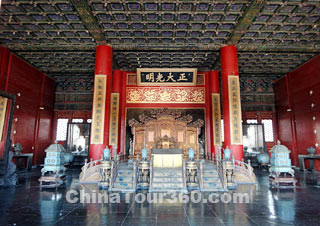Palace of Heavenly Purity (Qianqinggong) was the living place of the emperor and the place for the emperor to deal with daily political affairs in the Ming Dynasty (1368 - 1644) and the early Qing Dynasty (1644 - 1911). Located inside the Gate of Heavenly Purity (Qianqingmen), it is superior to the other two palaces in the inner court of the Forbidden City. During the reign of Emperor Yongzheng in the Qing Dynasty, the emperor moved his chamber to Hall of Mental Cultivation (Yangxindian). Since then, the Palace of Heavenly Purity became the emperor’s important audience hall, where he held banquets and ceremonies, and received ministers and envoys.
|
|
Originally built in 1420, the Palace of Heavenly Purity was destroyed and reconstructed several times during the Ming and Qing dynasties. The Palace we now see dates from 1798, with an imperial throne in the central of the palace, and warmth chambers on both sides.
Walking into the Palace of Heavenly Purity, you will see a board with four Chinese characters 正大光明 "Zheng Da Guang Ming" (be decent, honest and magnanimous) written by Emperor Shunzhi hung over the throne. Behind the board, there used to be a secret box holding the name of the following crown prince. In Chinese history, the competition for throne succession was fierce among the emperor’s sons. In order to relieve the conflicts, Emperor Yongzheng set up a policy of choosing the crown prince secretly. During the lifetime, the emperor wouldn’t release the name of the crown prince. He just drew up the document secretly, and placed it beside himself. He would also make a copy of the document and sealed it in the box. After the emperor died, the appointed officials would open the box and compared it with the other document beside the emperor. They would announce the name of next emperor after verification.
As the most important palace in the Inner Court of the Forbidden City, the Palace of Heavenly Purity was also the place for holding ceremonies. Two grand "1000 Elders'" banquets, one of the important banquets in the court of the Qing Dynasty, were held in this palace in 1722 and 1785 respectively. These two banquets were regarded as the symbol of the last flourishing age of the Chinese feudal history.
In addition, the Palace of Heavenly Purity also served as the funeral hall of the emperors in the Qing Dynasty. No matter where the emperor died, his coffin would be carried to this palace and placed there for several days. Then the coffin would be moved to the Hall of Observing Moral (Guandedian) in Jingshan Hill, and finally buried in the imperial mausoleum.
Palace of Heavenly Purity also has some cultural relics worthy of appreciation. For instance, there are two gold-plated bronze pavilions standing on each side of the terrace in front of the palace. On the terrace, there is a bronze turtle and a bronze crane sculpture on each side. Together They indicate longevity and symbolize that the dynasty will be passed down for thousands of generations. Outside of the palace, there is a sundial (an ancient timer) in the east and a Jialiang (an ancient measurement instrument) in the west. These two symbolize that the emperor was impartial and disinterested both in time and space, and the emperor was frank and equal to all his people.
![]() Go to the Next Attraction: Hall of Union & Peace
Go to the Next Attraction: Hall of Union & Peace










